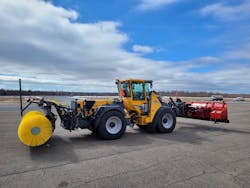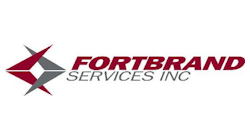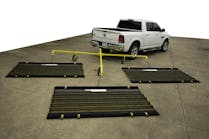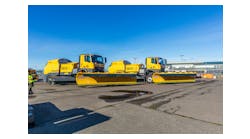Small Airports See Big Gains from Multitasking Equipment
The Hazleton Regional Airport (HZL) is enhancing its airfield operations with the investment in multitasking airfield equipment designed to meet the needs of smaller airports.
The airport implemented a Willie 865 MTE in March to address year-round tasks on the airfield while bringing a new level of efficiency to snow removal efforts.
The Willie is a hydraulic tool that articulates all-wheel drive similar to a loader. It has three areas on the machine that produces hydraulic power, so the operator can mount a plow on the front, a broom on the back, a cold air blast over the hood; or a solid or liquid spreader.
“One person plows, brooms and air blasts simultaneously,” Carlton Braley, Senior Vice President of Sales for Fortbrand said. “They had a loader previously where they'd plow, then they would have to go back into the barn, take the plow off, put a broom on, boom, take the broom off, put a blower on, blow, and triple the time plus the time to change the apertures.”
The Willie 865 is designed specifically for smaller airports like HZL. It’s large enough to clear taxiways, ramps and runways the size that Hazleton has. Equipped with a 150hp engine, the unit is constructed of ¾” welded steel, giving it the durability to last upwards of 20 years of service in an airport environment.
HZL is owned by the city of Hazelton, PA, which provided used snow removal equipment at the airport. The antiquated equipment was cumbersome and not designed for airfield operations. Multitasking equipment designed for airfield use allows one operator to perform three different functions and provide a level of efficiency seen at larger commercial airports.
“We’re going to be able to be able to clear the runway in six passes with this,” HZL Airport Manager Dave Chronowski said. “It’s going to increase our time open if we have a major snowstorm.”
Chronowski said the airport looked at several options besides the Willie, but they needed additional attachments and required airport staff to get out of the equipment and physically attach or detach attachments during a weather event. The Willie MTE doesn’t meet federal Buy America requirements, so the airport needed to secure funding from the Pennsylvania Department of Transportation (PennDOT). “The thought process for me was working smarter not harder,” Chronowski said. “We wanted a safe machine and we wanted something our employees would be safe in and not have to take on and off a lot of attachments in a midst of a snowstorm and possibly get injured.”
HZL needed a piece of equipment with a 16-foot plow and a broom. The Willie includes an air blaster to blow light amounts of snow off runways and taxiways, which Chronowski said made it the favorite choice for airport leadership. Willie also agreed to service the equipment on site if issues arise.
“That service agreement was huge,” Chronowski said. “Their support was a big factor in buying this piece of equipment. You don't always see that when you purchase equipment and having a support team that backs up their equipment up like that was a big factor for me.”
The airport purchased the Willie through Fortbrand. They set up a training date with HZL employees, who brought Willie staff in to train them on the equipment.
Braley said operation of the Willie is more technical than traditional loaders given it performs three tasks at once. Everything operates off a multi-buttoned single joystick, so once operators are trained, they’re a lot more efficient in handling winter weather operations.
“The staff was very excited. It was like everyone was getting a Christmas present,” Chronowski said. “The employees working here have a ton of aviation experience, so they really appreciate having a piece of equipment like this as a smaller airport. We’re hoping to buy more pieces of equipment like this in the future to help the airport run more efficiently and get the job done.”
HZL purchased the Willie 865 for the purpose of winter weather operations, but the airport can purchase additional attachments for the unit to make it a four seasons tool.
“We can use the air blast all year long for debris cleaning,” Chronowski said. "We can also purchase attachments for cutting grass.”
Airports can seek a waiver for Buy American requirements if choosing to use AIP funding to purchase equipment like the Willies. PennDOT assisted HZL after seeing the impact it would have on operations at the airport.
“The leadership at Hazleton had foresight and has seen the benefit of multitasking equipment during winter operations,” Braley said. “It’s important to have the right leadership in place to make something like this happen to improve the airport and stand up for the airfield crew and the safety of the community.”
Chronowski recommends getting frontline employees involved in the decision-making process when it comes to buying airfield equipment. Find out what their goals are and what equipment can get them to accomplishing those goals in the safest manner possible.
“We're definitely working smarter, not harder,” he said. “It puts them in an environment where they can get a lot accomplished in a short period of time and they're in control of a lot of different functions," he said. "You're going to get a lot more project productivity out of your employees if they're happy with the equipment they're using. You're putting them in a safe piece of equipment and that's the utmost importance.”
Braley suggests airports look at their operations during a winter weather event and how long it takes to maintain a safe landing surface along with demand brought on by community safety or business aviation traffic. Multitasking equipment is attainable for smaller airports and can improve winter weather operations through more efficient operations.
“Small hub, non-hub, general aviation types of airports struggle in the wintertime because they don't have the resources to keep their airports open, yet their airport is more needed for emergency purposes because of car accidents, snowmobile accidents and other activities that take place during a snowstorm,” Braely said. “Airports have been demanding a piece of equipment like this for years so one or two people can keep their airport open.”






